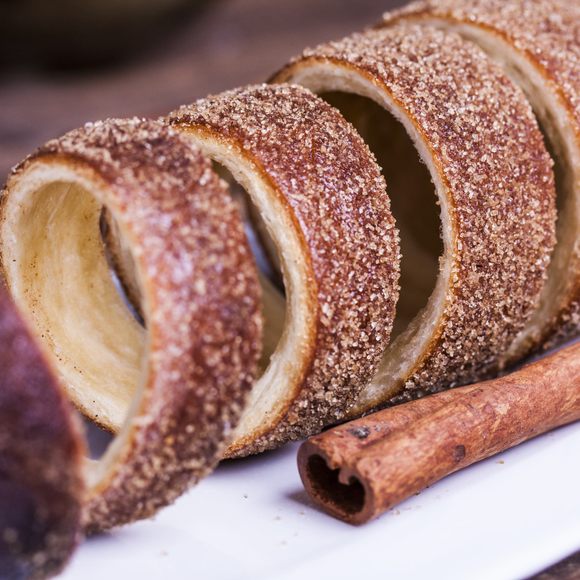Sweets
Chimney Cake
After rotating over hot coals, the Transylvanian treat unravels in a sweet spiral.
Have you ever tried a barbecued cake from Transylvania? If not, you’ll want to add the chimney cake to your bucket list of culinary curiosities.
Kürtőskalács originates in the Hungarian-speaking regions of Romania. It gets the nickname “chimney cake” from its cylindrical shape, which comes from rolling the dough around a wooden spit that rotates over hot cinders (similar to Lithuanian spit cake). As the cake “bakes,” its sprinkling of sugar melts into a sticky caramel coating. As soon as it’s finished, bakers dust the hot cake with cocoa powder, cinnamon, ground walnuts, or other toppings. The thin, hollow cake is perfect for when you’re on the go, as you can just tear off the warm, spiraling strips by hand. It tastes a little bit like a brioche, but with a firmer, less bready texture that’s pleasantly on the chewy side.
So where did this spit-roasted dessert come from? A 1450 manuscript from Heidelberg, Germany, describes similar cakes cooked on a spit over hot coals, but the earliest recipe for kürtőskalács dates back to 18th-century Transylvania. A 1784 cookbook by Countess Mária Mikes of Zabola lists it as “kürtős kalats à la Mrs. Poráni.” Though this version forgoes any sweetness, a sugar glaze has since been rolled into the cake’s recipe. Today, kürtöskalács is always served as a sweet treat.
Traditionally, kürtőskalács was a wintertime snack you’d find roasting over coals in sidewalk kiosks around Christmas, but its recent popularity made it a dish for all seasons in regions of Central and Eastern Europe.
Where to Try It
-
Transylvanian Traditions Bakery
1111 Davie St, Vancouver, British Columbia, V6E 1N2, CanadaTiny bakery in Vancouver's West End with a variety of Transylvanian sweets.
-
House of Chimney Cakes
173 W CENTER STREET PROMENADE , Anaheim, California, 92805, United StatesThis Anaheim bakery makes cakes with a variety of coatings, including coconut, chocolate, and Fruity Pebbles.
Written By
 jwalker
jwalker









 JamazingClayton
JamazingClayton








